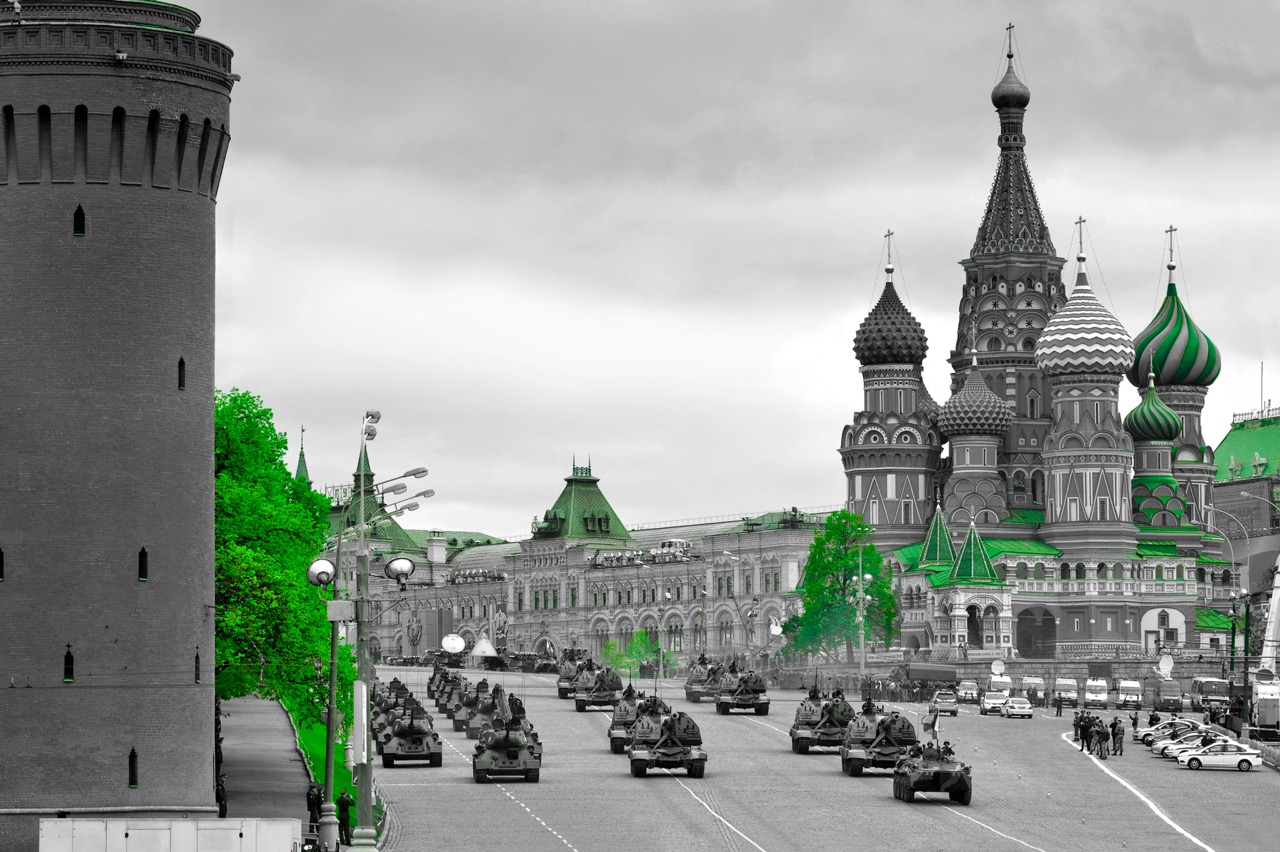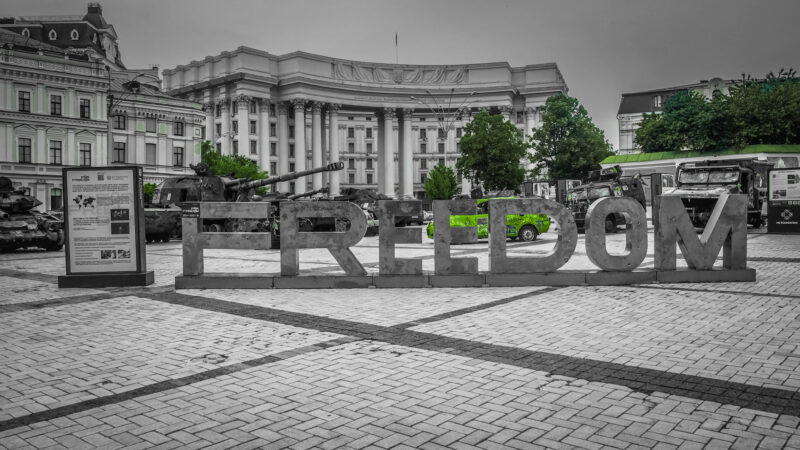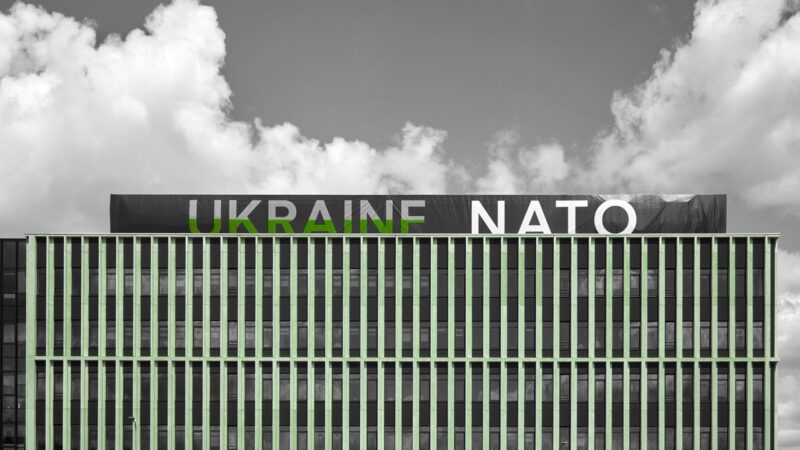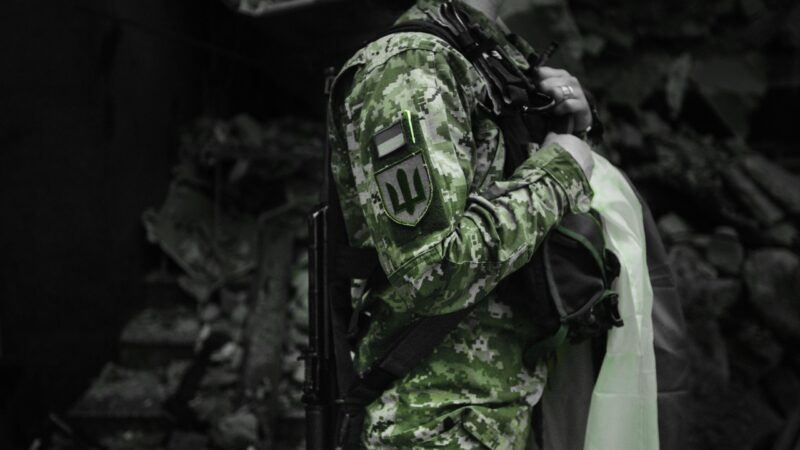Cultural Othering: Russia’s infallible weapon of war against the collective West and Ukraine

The USA and the West are “truly an empire of lies,” so obsessed with the inevitable and continuous loss of its slipping neo-colonial possessions that it has started a bloody hybrid war against Russia, declared Russia’s Minister of Foreign Affairs Sergei Lavrov without a trace of irony in his most recent address to the UN General Assembly. A mere few weeks prior to Lavrov’s speech, Russia’s President Vladimir Putin (who coined the term “empire of lies” in relation to America[1]) accused the West of having placed “an ethnic Jewish neo-Nazi and followers of Adolf Hitler, covering up Nazism and fascism, at the head of Ukraine.” It has been insinuated that Putin’s own Jewish friends criticize Ukraine’s President Volodymyr Zelensky as “a disgrace to the Jewish people,” a traitor, a fascist, and “a Jew who covers up the glorification of Nazism and those who led the Holocaust in Ukraine.” According to Putin, an anti-human essence forms the very foundation of the modern Ukrainian state, “a state that puts Hitler’s followers on a pedestal of honor.”
Neo-Nazism and fascism are not the only characteristics that Putin and his political entourage have recently granted Ukraine and its people. In the popular, heavily propagandized, and quickly spreading Russian view, Ukraine has never had its own statehood and has always been ruled by corrupt and politically unfit oligarchs, criminal clans, and radical Russophobic nationalists, many of whom eagerly joined terrorist gangs in the North Caucasus. According to Russia’s top religious leaders, Ukraine is also a “lawless” and “satanic” state. The head of the Russian Orthodox Church, Patriarch Kirill, enthusiastically supports Russia’s war in Ukraine and has even defined the war as “holy,” blessing young Russian conscripts and promising them that dying in Ukraine washes away all sins.
The principles of the Russian worldview, hewn to by the rules of Russian rhetorical and military engagement with real and imaginary foes, are predictable: they always follow the infallible formula “whoever’s not with us is against us.” This overused phrase became popular in Soviet Russia soon after the 1917 October Revolution. It was inspired by Pyotr Zaichenevsky in his “Young Russia” proclamation in 1862, a call for a widespread armed uprising. The phrase became particularly famous at the end of 1905, when poet Nikolai Minsky composed the “Workers’ Anthem,” which read, “Whoever’s not with us is our enemy and must fall.” Since then, the phrase has been used as a threat or warning to those who take a neutral political position or dare—as the Wagner mercenary group’s chief Evgenii Prigozhin recently did—rebel against the official Moscow. The outcomes and the discourse are carefully orchestrated and controlled by the Kremlin.
Controlling the narrative about the Self and the Other has always been essential for Russia’s ideological survival and national self-identification—during its imperial era and through Leninism, Stalinism, the “Khrushchev Thaw,” and the uneasy post-Soviet transition. Thus, it’s no surprise that parallel to the murderous rockets mercilessly raining down on Ukrainian cities, the authorities in Moscow continue to shell their own country and the rest of the world with extremely negative, historically and factually false, and absurdly provocative rhetorical “frames.” Russia’s deliberate and repetitive framing—of the USA as an empire of lies, or the collective West as a deceitful Russophobic aggressor, or the Ukrainian president as a disgraceful Jew and a neo-Nazi, or of Ukraine itself as a cradle of neo-Nazism, terrorism, and Satanism—is a popular form of cultural Othering. As I explain in my new book, Communicating the Other across Cultures, it is an influential communicative tactic that has been used by different societies, in different forms and contexts, with the goal of gaining, maintaining, and exercising power.
Cultural Othering as equipment for living
Metaphorically speaking, cultural Othering is a form of “ideological Darwinism,” a social “survival of the fittest” phenomenon. The process of cultural Othering synonymizes any difference between Self and Other as deviance as a marker of social inferiority. It is rooted in identity politics and happens on multiple levels, ranging from individuals to institutions, nations, and cultures. Categories of identity—race, ethnicity, gender, religion, social class, or nationality—separately or in their aggregate, are ascribed and instrumentalized to create a cohesive and convincing narrative of hegemony. Cultural Othering is directly correlated with histories of domination and the portrayal and consequent perception of the Other as savage, animalistic, or criminal, to be civilized, tamed, or exterminated. Various -isms (e.g., racism, colonialism, fascism) and –phobias (e.g., xenophobia, Islamophobia) constitute popular forms of cultural Othering. The most extreme form of this process is genocide—which, like the Trail of Tears, the Holocaust, and the Holodomor, entails the cultural or physical death of the Other.
Putin’s Russia is very skilled at practicing cultural Othering, and Russia’s rules of military and discursive engagement in Ukraine clearly target both the cultural and the physical death of the Ukrainian Other. In the words of US Secretary of State Antony Blinken, “If Russia stops fighting and leaves Ukraine, the war ends. If Ukraine stops fighting, Ukraine ends.” Although in his speech Blinken refers to Russia’s escalated invasion that began in 2022, Russia’s ideological war against Ukraine and its people, fundamentally motivated by cultural Othering has been going on for much longer. Russia’s unprovoked war against Ukraine and the “collective West” started neither in 2022 nor in 2014, when the annexation of Crimea was celebrated in Russia a “re-unification with Mother Russia.” Today’s Ukraine is yet again a bloody arena for Russia’s continuous expansion, one of countless battlefields in Russia’s centuries-long attempt at the geopolitical, ideological, and informational conquest of its neighbours. Ukraine in 2022 , Crimea in 2014, Georgia in 2008, and 1999/1994 in Chechnya are only the most recent examples of Russian attempts to re-establish its former imperial and Soviet Communist hegemony over its former Others—the Ukrainians, Georgians, Chechens, and Crimean Tatars—all former subjects to Russia’s insatiable neo-imperialistic appetites.
Two choices for the former Soviet br/Others
From the Russian perspective, the numerous neighbours (former “brotherly republics”) that emerged from the break-up of the Soviet Union in early 1990s have two options/positionalities available to them on the world arena.
The first option is total geopolitical and cultural submission, assimilation, and unconditional loyalty to Mother-Russia and the hegemony of the Russkii mir (“Russian world”), in order to create and prioritize a pan-Russian sameness and superiority. This approach worked for the Kremlin during Soviet times, when all the 15 Soviet Socialist Republics were called “Brother s” within the Soviet superpower. Nationally and internationally, “Soviet” and “Russian” were used almost interchangeably, particularly abroad. Putin—the ultimate homo Sovieticus— repeatedly focused on that faux, pan-Russian sameness, denying the former republics their cultures and their statehood. During the 2008 NATO summit, while speaking with American President George W. Bush, Putin said: “You understand, George, that Ukraine is not even a state! What is Ukraine? Part of its territories is Eastern Europe, and part—a significant part—was donated by us!” Later, just a few days before Russia’s escalated invasion of Ukraine, on 21 February 2022 Putin declared that contemporary Ukraine was created by the Russian Communists Vladimir Lenin and his associates, right after the 1917 October brutally revolution, by giving away historically Russian lands. He continued with more historical nonsense, claiming that a great Russia once existed, of which Ukraine was but a part, and fully denying the truth that Rus’ was in fact the mother of all “Russian states,” including contemporary Russia. Calling Lenin “the creator and architect of Ukraine,” Putin criticized Lenin for having satisfied all the boundless nationalist ambitions of ungrateful and undeserving Ukrainian nationalists on the outskirts of the former Russian Empire.
The second option for the post-Soviet republics—sovereign national and cultural self-definition—has an extreme disadvantage in that it immediately makes them subject to the most extreme forms of Russia’s cultural Othering. Specifically, following the disintegration of the USSR in 1991, the br/Others who had dared to break away from Russian hegemony, craving democratic freedoms and developing pro-Western ambitions, were turned into an enemy. Following the above-mentioned formula “whoever’s not with us is against us,” those disloyal rebels became subjected to Russia’s second, radically different perception and treatment of neighbours as undeserving, culturally inferior, hostile, and dangerous Others—who, in the words of Putin, base their identity on Russophobia, fascism, and neo-Nazism and are directly associated with Hitler’s former collaborators. Rhetorically, the new enemies (for example, the uncooperative Ukrainians already in 2014, during the Euromaidan revolution) quickly became targets of cultural Othering, the reliable modus operandi of the tireless Kremlin propaganda machine. The old formula of the “Great Russians,” liberators, the moral light of the world, the misunderstood martyrs versus the “evil, traitorous Other,” the criminals, the degenerates, the enemy has been an essential part of the Russian national rhetoric—be it verbal (from Bildungsromane to public speeches), visual (propaganda posters, film, and media), or material (sites/spaces, museums and memorials, and even the currency in one’s pockets).
Russian cultural Othering: A mélange of the old and the new
Russia’s cultural Othering is paradoxical: on the one hand, it’s quite time-sensitive, like the framing of Ukraine as a fascist, terrorist, satanic state led by a disgraceful Jew and a bunch of Hitler’s followers. On the other hand, that particular refrain of cultural Othering is not entirely new: in fact, it is deeply historical and is based on the long, long history of Russia’s discursive imperialism and its culture of hegemony and groupthink.
Already Imperial Russian literary giants Pushkin and Tolstoy glorified Russian martyrdom and patriarchal militarism, accompanied by cultural Othering of the French, Swedes, Turks, Circassians, Crimean Tatars, Ukrainians, Georgians, and Moldavians. In his epic poem “Poltava,” Pushkin demonized Hetman Mazepa (a Ukrainian national hero), portraying him as a sexual predator and a bloodthirsty monster obsessed with going to war against the hated Moscow and betraying Emperor Peter the Great. Pushkin’s other poem and Tolstoy’s subsequent novel with the same title, Prisoner of the Caucasus, both demonize the Caucasus natives, the Circassians, as savage bloodthirsty exotic highlanders. Pushkin and Tolstoy are mandatory in Russian schools.
Similar cultural Othering happened during the Soviet era, first under Lenin and later under Stalin. Under Stalin’s leadership, the doctrine of Leninism was solidified with an iron grip, an formidable propaganda machine, forced Russification, groupthink, and colonizing Sovietization to the point of the absolute triumph of a homogenous Soviet identity over the union’s former ethnic and class diversity. The Soviet national anthem communicated this world view best: “Unbreakable Union of freeborn Republics, Great Russia has welded forever to stand. Created in struggle by the will of the people, United and mighty, our Soviet land!”
Meanwhile, the GULAG served as the ultimate destination for unassimilable Others. The most notorious camp of the Gulag Archipelago, the Solovets Islands (Solovki) special camp promised in its slogan: “With an iron hand we will herd mankind to happiness.” The Soviet poet Maiakovskii (another mandatory school subject), referring to the 1917 October Revolution, writes in “For our youth,” “Comrades, youths, look up to Moscow! […] When October gunfights’ blood ran in the streets, I know that in Moscow the fate of Kiev and Tiflis was decided.” Even in 1917 Moscow had already decided to Russify and Sovietize Ukraine and Georgia, brutally breaking any resistance on their part.
History also shows just how brutal the punishment was for resistance and disobedience. Ukraine paid a horrible price: the 1923 and 1933 Holodomors (Bolshevik manmade famine) cost the lives of up to twelve million Ukrainians. Then, the mighty Soviet propaganda machine silenced the Ukrainian genocide and discursively othered the Ukrainian fight for independence as a criminal and treacherous act of betrayal of the Soviet Motherland, equal in its evilness to the atrocities of Nazi Germany. Cultural Othering succeeded in all the discursive domains: literature, politics, education, film and media, museums, and memorials. The formula “whoever’s not with us is against us,” paired with cultural Othering, worked quite well for the USSR… Then, 1991 happened, with Ukraine and other republics striking out on their own, albeit in various stages of post-colonial stress and culturally damaged from the legacy of imperial and Soviet Russian hegemony.
Putinization of power: a déjà vu with Russia’s imperial past
In 2000, Vladimir Putin succeeds Boris Yeltsin as president of the Russian Federation. In 2005, he declares that the fall of the USSR was the biggest geopolitical tragedy of the previous century and attempts to regain the former authoritarian glory of the Russian reign. Imperial and Soviet nostalgia, Russian martyrdom in WW II, and anti-fascism are central to the Russian world view. Along with cultural Othering, this presents a definite déjà vu: another Russian invasion, framed as “liberation,” “demilitarization,” “de-satanization,” and “de-nazification.” Using (and abusing) history and collective memory, Russia continues to follow the same formula of cultural Othering. This time, the Others are Ukrainians and their supporters in the “collective West.” Absurdly, although 8 million Ukrainians lost their lives in WW II fighting against Nazi Germany, they are now labelled “Nazis”! “Whoever’s not with us is against us” means that you are either a Brother (in arms!) or the Other… No less ironically, there are Chechens fighting alongside the Russians today in Ukraine.
Russia’s present war in Ukraine, paralleled by the grotesque yet explainable renaissance of Russian nationalism, is a direct outcome of successfully implemented cultural Othering as a form of “ equipment for living” in the globalizing world. In Putin’s autocratic Russia, informationally isolated from the rest of the world, this equipment works exceedingly well. The minister of propaganda in the Nazi German government of the Third Reich, Joseph Goebbels, often declared that “if you tell a big enough lie and keep repeating it, people will eventually come to believe it.” Putin’s Russia is certainly a case in point. Ultimately, cultural Othering serves as an infallible weapon of Russia’s information war against the West, as well as a strategy that fuels, justifies, and even glamorizes the actual war in Ukraine for countless Russian conscripts and their devastated families.
What’s next? A long war…
The impact of cultural Othering is astonishingly effective: the perpetrator (invader, colonizer, genocide practitioner, tyrant) feels like a liberator, an educator, a peacemaker, and a restorer of the correct world order…
A case in point: in November 2021 President Putin symbolically (re)set Russia’s history of 2014-annexed Crimea in stone (and metal) when he inaugurated a memorial complex in Sevastopol that was dedicated to the end of the Russian “Civil War.” Standing next to the majestic structure, which symbolizes Mother Russia in the form of a gilded goddess, elevated above the erstwhile belligerents, Putin re-emphasized the importance of Crimea’s reunification with the rest of the Russian Federation. He declared: “We are a single people, and we have only one Russia,” and it is because of that unity that “the people of Russia have achieved remarkable heights in economics, science, technology, and culture.” Putin added “Sevastopol and Crimea are now with Russia and will stay with it forever, because this was the expression of the sovereign, free, and uncompromising will of our entire people.”
The fact that the indigenous peoples of Crimea—the Tatars, themselves victims of Russia’s systematic resettlements and a Stalinist genocide in 1944—are not even mentioned in the discourse shows how skillfully cultural Othering was performed on the occupied peninsula. For millions of Russians, such Weltanschauung is commonsensical, but as a toolkit for living with the non-Russian Other, it has not changed since the times of Pushkin and Tolstoy.
As if the years of Imperialism, Leninism, and Stalinism were not enough, having accepted and supported Putinism, Russia has now marched into another war—a war in which, according to the Russian popular view, “the United States continues its line of de facto fighting with Russia until the last Ukrainian.” Given the history of Kyivan Rus‘ as the cradle of Russian civilization, this Russo-Ukrainian war constitutes a combined ethnic fratricide and matricide—the ultimate manifestation of cultural Othering, ad absurdum. A war which is not set to end any time soon.
[1] This term is a quid-pro-quo response to the well-known “Evil Empire” epithet that was bestowed upon the USSR in 1983 by the POTUS Ronald Reagan.




